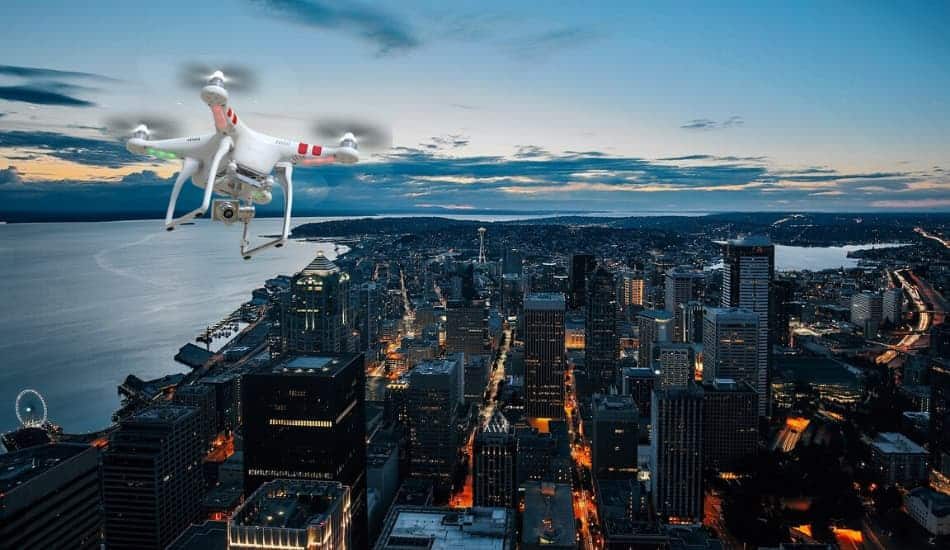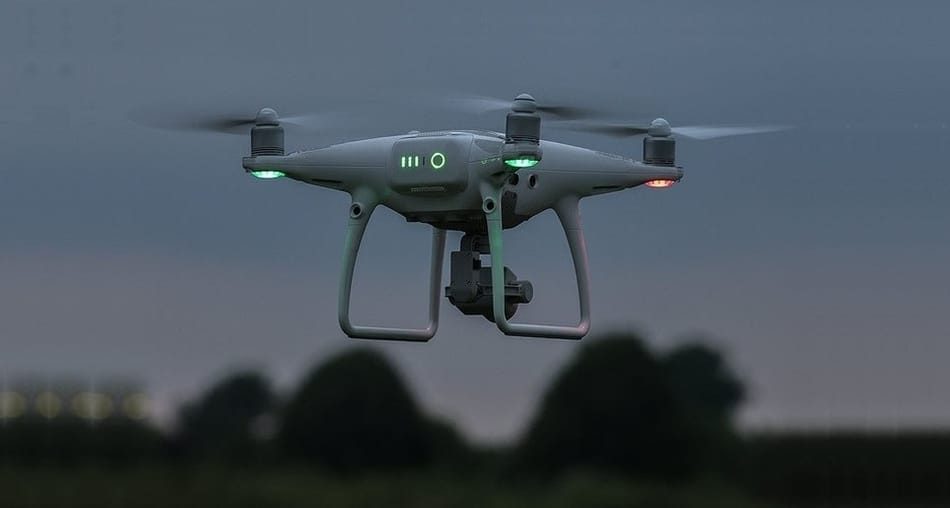Can Drones Take Pictures At Night?

While most people use a drone during the day, drone can be even more attractive and fun during the night. A night flight allows you to take breathtaking pictures of fireworks, illuminated castles, cities in night traffic or, for example, open-air concerts. But taking pictures at night requires a quality camera and adjusting some specific settings on your drone. Also, flying at night is always very risky, because you do not have a clear view of the situation as you have it by day. Wind also plays the role here. The higher you go, the more windy it will be. Let’s see what it takes to take great photos at night.
So Can Drones Take Pictures At Night? Yes, drones are capable of taking good pictures even at night. Most of the drones have specific night flight settings that must be adjusted for night photography. Important flight settings that need to be adjust are: image format RAW (DNG), ISO settings, mechanical shutter, gimbal, front LEDs and tripood mode.
“Flying a drone at night is considered illegal and dangerous in most of the countries around the world! Check the laws in your country first to avoid such a penalties.”
Important camera settings for drone night photography:
| Settings: | Description: |
|---|---|
| 1. RAW (DNG) | Only RAW files, avoid JPEG. |
| 2. Mechanical Shutter – OFF | When this is off, it'll eliminate the tiny vibrations after the shutter goes off. |
| 3. Lock Gimbal – ON | Keeps gimbal locked in position |
| 4. Front LEDs – OFF | This will stop the red lights from coming into the camera. |
| 5. Tripod Mode - ON | This will keep your drone super steady in the air. |
Can I Fly My Drone at Night as a Hobbyist?
Yes, you can! You are not required to have a license for night flight if you are a hobbyist. What you need to do is to comply with certain rules for safe flight by the Federal Aviation Administration (FAA). If you follow those rules, and not losing or crashing your drone you will have no problems with the law. Some of that night flight rules are: avoid flying near airports, fly drones that weigh less than 55 lbs, fly your drone within visual line-of-sight.
How to Take Stunning Photos With a Drone at Night?
If you have a super stable drone, a good camera mounted on a three-axis stabilizer, all you have to do now is take a good night shot. The first thing that you need to do is switch to manual mode, so you can choose your settings. Move the ISO value down at 100 or as low as possible to have brighter picture. You also need to increase the shutter speed. To drag the most light to your photos, the shutter speed of 5 to 8 seconds is perfect. To do that, start by testing different shutter speeds, until you get the right one. It all depends on the result you want to achieve, the stability or wind in flight. You should also turn off the front LEDs on your drone, so you dont get any red ink on your pictures. White balance is also important. You can manually adjust the white balance via your camera, then adjust if necessary based on the ambient light.
Finally, set your picture format to RAW (DNG). The RAW format has a greater dynamic range than JPEG: 2 to 4 EV, and above all makes it possible to manage and compensate for exposure problems or bench balances on image processing software in post production. The only limits here are those imposed by your environment. Let your imagination run wild by playing with different light sources and use reflections to your advantage. As you can see, taking night aerial photos is fairly easy when you know the right settings. And finally, take multiple shots during the flight, that is the key!
Legend:
FOCUS – If your drone has the capabilities of manually focusing, turn it ON. Turn manual focus assisting ON, then begin rack focusing until you see the lights and the building becomes super crisp and sharp. Once you see sharp images, you’re ready to go.
ISO – measures the sensitivity of the camera to light. The lower ISO value will give you a darker image. The higher ISO value will give you the brighter image.
Aperture – is a hole or an opening that allows light to go into the camera. It can be controlled thgrough the lens or the camera. The lower value give us a brigher image, the higher value give us a darker image.
Shutter speed – also known as exposure time is a measurement of time where the shutter of a camera is exposed to the light. This is measured in seconds or fractions of a second (1 s, 1/4s, 1/8s, etc.).
How to Prepare Your Drone for Night Flight Photography?

I wrote an article of: 10 Best Drones For Night Photography 2020 , so if you are interested go check out and see what are the top best models for night aerial photography.
1. Choose a Stable Drone
In aerial photography, stability is certainly the most important criterion for successful long exposure photos – with the aperture of the camera and the shutter speed. There are many drones capable of providing very high stability during flights such as DJI Mavic Pro , Phantoms 4 and others. Therefore, it is important to have a drone with a quality sensor to obtain good results in high sensitivities like that of the Phantom 4 Pro for example! Tip : You can improve the stability of your drones by using carbon propellers on some models. These propellers can provide greater precision of movement and better stability with the possibility of slightly increasing the charge of the drone.
2. Inspect the Area in Advance
Detailed knowledge of the area where you will fly is a critical step to get the best photos as possible. If you have never flown in that area before, I advise you to do so during daylight hours. By doing that, you may notice small environmental changes that may have an impact on your night photography. Also find your takeoff and landing location during the day. Notice if there are many trees or tall buildings around you that could affect your flight during the night. You won’t be able to see them best during the night, so you need to keep that in mind.
3. Test the Settings Before Takeoff
While some drones, such as the DJI or Parrot allow remote camera adjustments, most other quadcopters do not always have these types of options. In view of the relatively short flight time of these machines, it is not always advisable to lose 3 or 4 precious minutes to modify the settings in mid-flight. To do this, make your settings according to the type of photo/video you want to take before taking off with your drone. Position your camera at a low angle of inclination during the flight, around 15° maximum, which will allow you to achieve fluid movements, especially in traveling mode and to avoid having propellers in the frame.
4. Check Your Battery Status
Before every flight, you need to recharge your batteries to 100%. By this you can avoid any potential risk that may occur during the flight. If your drone for example has a 20% charge remaining, the drone tells you to slowly return to home (RTH). At 10%, however, it automatically begins to land on its own, no matter where you are. So, in order not to lose your drone during the flight, always recharge your batteries and preferably have a spare battery with you.
5. Take Into Account The Weather Conditions
Make sure you check the weather during the night, and be especially careful when flying in strong winds. If bad weather turns out, delay your shooting for another night. The quality of your photographs and videos may deteriorate if the weather conditions are not optimal. The weather can significantly affect piloting and shooting. To avoid this, it is best to avoid flying when the wind is too strong, the temperatures are very high or very low or if there is a rain or the snow.
The Pros and Cons of Taking Pictures at Night
PROS:
- Beautiful aerial photography
- Unique Experience
- Breathtaking pictures
CONS:
- Test your drone and adjust the settings
- You need to plan the shooting
- Take into account the weather
Conclusion
And finally, if you decide to fly with your drone during the night to shoot some amazing footage, this could be an awesome experience. Most photographers like to take long exposure photos at night because they give a unique scene. Taking pictures at night is a challenge, because you don’t see the environment around you, so you need to do a test flight during the day to get a better view. Safety comes first! None of us want to crash our drone just to take some footage during the night. Keep in mind that you must always follow the regulations issued by the FAA. Now that you’ve learned how to do it, and what the laws are, you are now ready to take some amazing night footage and wait for the night. Good luck, and have fun!

